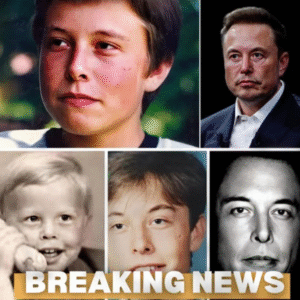From Bruises to Breakthroughs: The Shocking Truth Behind Elon Musk’s Journey to Change the Universe
Before the rockets. Before the Teslas. Before the headlines and controversies and billion-dollar valuations, Elon Musk was just a boy—awkward, introverted, and relentlessly curious. Born in Pretoria, South Africa, in 1971, Musk didn’t fit in. He wasn’t athletic. He wasn’t popular. He was obsessed with books and computers, and that made him a target.
“I had a terrible upbringing,” Musk once said. “I had a lot of adversity growing up. One thing I worry about with my kids is they don’t face enough adversity”.
He wasn’t exaggerating. As a child, Musk was bullied so severely that he was once hospitalized after being thrown down a flight of stairs. His classmates mocked him for being different. For asking too many questions. For dreaming too big.
But Musk didn’t shrink.
He read. He coded. He imagined.
And that imagination became his armor.
🧠 The Bookworm Who Built Worlds
Musk’s childhood was defined by solitude and science fiction. He devoured books—fantasy, physics, philosophy. He taught himself computer programming and sold his first video game, Blastar, at age 12. While other kids played soccer, Musk was building digital galaxies.
He once said, “The things that are worth doing are trying to improve our understanding of the world and gain a better appreciation of the universe… Life’s pretty good. It really is”.
That mindset—equal parts wonder and grit—would carry him through decades of rejection, ridicule, and reinvention.
🔥 The Escape and the Ascent
At 17, Musk left South Africa for Canada, then transferred to the University of Pennsylvania, where he studied physics and economics. He dreamed of space travel and electric cars, but first, he had to survive.
He lived on $1 a day. He showered at the YMCA. He cold-called executives and pitched ideas no one understood—yet.
In 1995, he dropped out of Stanford after two days to launch Zip2, a city guide software company. Four years later, he sold it for $307 million. Then came PayPal, which he co-founded and sold to eBay for $1.5 billion.
But Musk wasn’t chasing money.
He was chasing meaning.
And that meant going bigger.
🚀 The Man Who Dared to Leave Earth
In 2002, Musk founded SpaceX with a singular goal: make humanity a multi-planetary species. People laughed. NASA doubted him. His first three rocket launches failed spectacularly.
He poured his fortune into the company. At one point, he was days away from bankruptcy.
Then, in 2008, SpaceX’s fourth launch succeeded. It reached orbit. And everything changed.
Today, SpaceX is the backbone of modern spaceflight. It’s launched astronauts to the International Space Station, deployed thousands of Starlink satellites, and developed reusable rockets that have slashed the cost of space travel.
Musk’s ultimate goal? Colonize Mars.
Not as a stunt.
As a safeguard for humanity.
“If something happens to Earth,” he said, “we want to make sure life continues somewhere else.”
⚡ The Electric Revolution
While building rockets, Musk also took on the auto industry. In 2004, he joined Tesla Motors, a fledgling electric car company. Critics called it a vanity project. A billionaire’s toy.
But Musk saw the future.
He pushed Tesla to innovate—developing sleek, high-performance EVs that shattered stereotypes. The Model S, Model 3, and Model Y became global sensations. Tesla’s Gigafactories now produce millions of vehicles annually, and the company’s valuation has soared past $800 billion.
Musk didn’t stop there.
He launched SolarCity to revolutionize clean energy. The Boring Company to rethink urban transportation. Neuralink to merge brains with machines. And OpenAI to ensure artificial intelligence benefits humanity.
Each venture is audacious.
Each one began with a question.
“What if?”
🧵 The Price of Vision
Musk’s journey hasn’t been smooth. He’s faced lawsuits, scandals, and public meltdowns. His tweets have tanked stock prices. His leadership style is often described as brutal. Demanding. Unforgiving.
But beneath the chaos is consistency.
Musk works 100-hour weeks. Sleeps in factories. Reads obsessively. Thinks in systems. He’s not trying to be liked.
He’s trying to build.
And that obsession has made him both admired and feared.
“He’s like a machine,” one former employee said. “But he’s building the future.”
🌿 The Man Behind the Myth
Despite his fame, Musk remains deeply private. He’s a father of ten. He’s spoken openly about his struggles with Asperger’s Syndrome, which affects social interaction and communication. He’s battled depression, used ketamine to manage his mental health, and undergone multiple surgeries for spinal injuries.
He’s not invincible.
He’s human.
And that humanity—flawed, brilliant, relentless—is what makes his story so compelling.
He’s not just changing the universe.
He’s proving that pain can become power.
💡 What We Learn
From Elon Musk’s journey, we learn that adversity is not a dead end. That being different is not a weakness. That imagination, when paired with resilience, can reshape reality.
We learn that failure is part of the process. That rejection is fuel. That the most powerful ideas often begin in silence—between the pages of a book, in the mind of a bullied boy.
We learn that greatness is not about perfection.
It’s about persistence.
And we learn that the future isn’t waiting to be discovered.
It’s waiting to be built.



